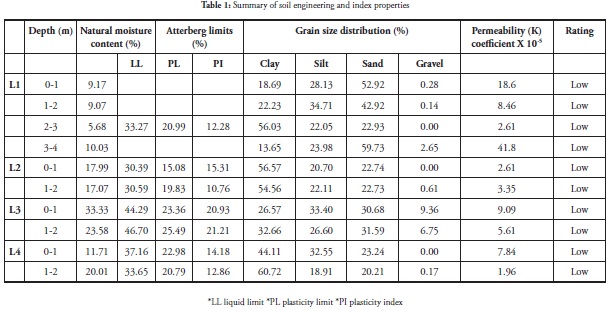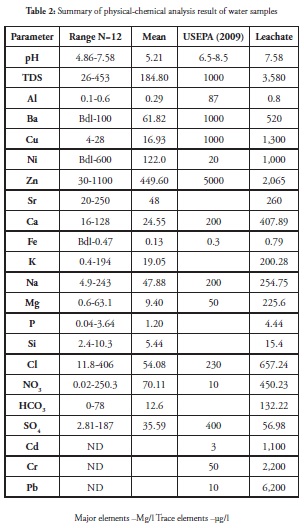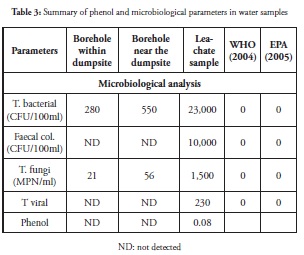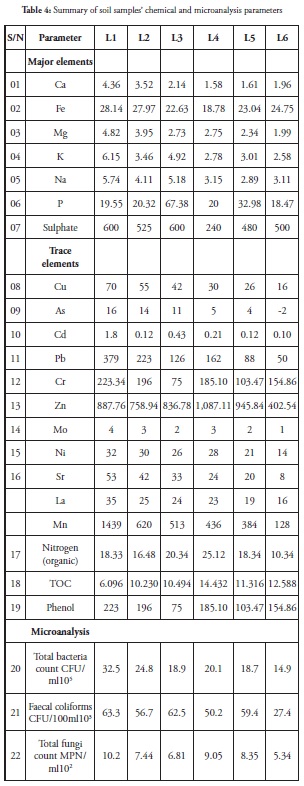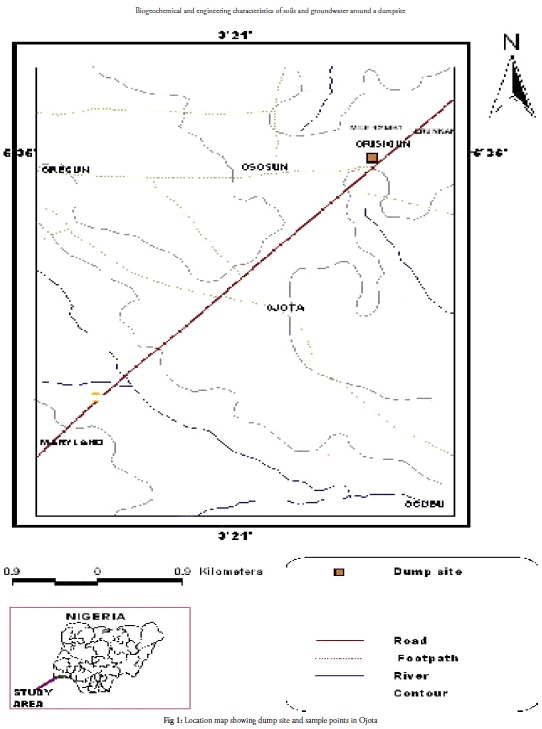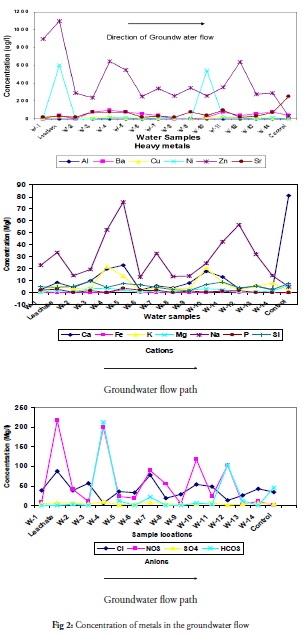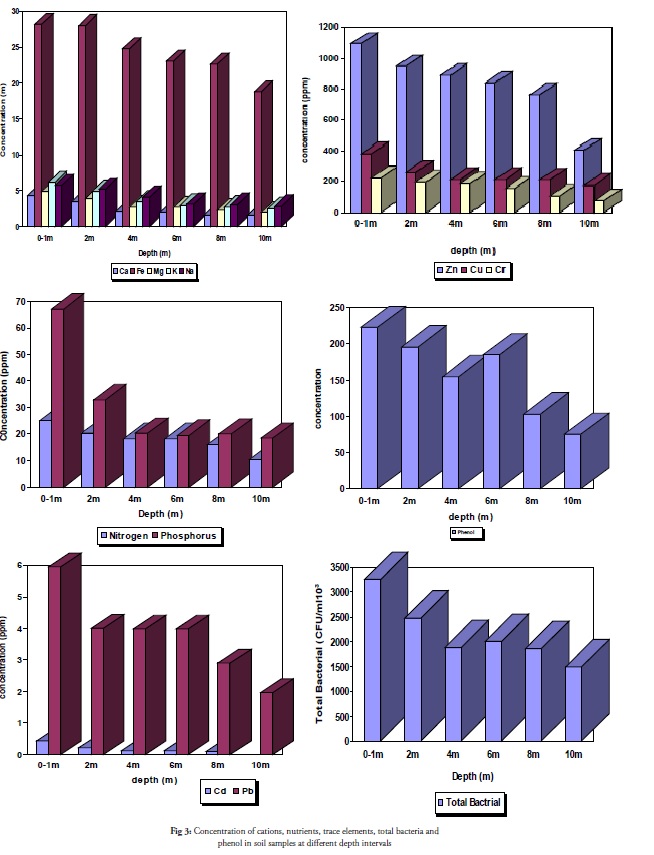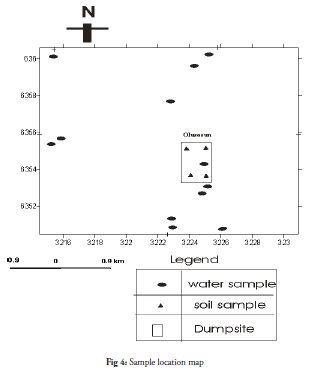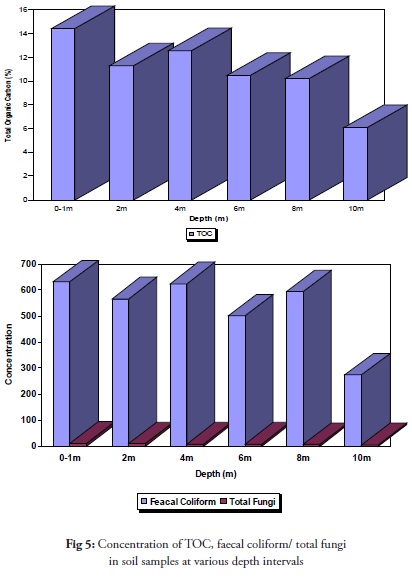Services on Demand
Journal
Article
Indicators
-
 Cited by SciELO
Cited by SciELO -
 Access statistics
Access statistics
Related links
-
 Cited by Google
Cited by Google -
 Similars in
SciELO
Similars in
SciELO -
 Similars in Google
Similars in Google
Share
Earth Sciences Research Journal
Print version ISSN 1794-6190
Earth Sci. Res. J. vol.17 no.1 Bogotá Jan./June 2013
Biogeochemical and engineering characteristics of soils and groundwater around a dumpsite
Odukoya AM1, Oresanya O2 and Abimbola, A.F3
1 Department of Geosciences, University of Lagos, Nigeria. Email: sesanbiiodun@yahoo.com
2 Lagos State Waste management authority, Lagos, Nigeria
3 Department of Geology, University of Ibadan, Nigeria
Recibido: 26/01/2013 - Aceptado: 04/04/2013
ABSTRACT
An active dumpsite in Lagos south-western Nigeria was monitored to test natural attenuation efficiency in reducing contaminants by determining soil and groundwater biogeochemical and engineering properties within and around the site. From the Casagrande Plasticity Chart, the soil could be classified as clay or silt having intermediate to high plasticity; unsaturated zone thickness was 10-20m and permeability was low (1.96x10-5 to 41.8x10-5 m/s). Appropriate microorganisms, such as bacteria, viruses and fungi which are required for natural attenuation, were naturally present. Nutrients such as calcium, copper, magnesium, manganese, potassium, sodium and zinc, as well as electron donor (organic carbon) and electron acceptor (oxygen, nitrate, sulphate and iron), were also present in various amounts for effective natural attenuation. All the parameters analysed in water samples came within Environmental Protection Agency standards, except Fe, Na, Cl, NO3, Al, Ba, Ni, total bacteria and total fungi. Phenol and total viral count were not detected in the two boreholes studied, but they showed values as high as 10,000 MPN/100ml and 230 CFU/100ml, respectively, in leachate. The concentration of contaminants in the soil was very high and inversely proportional to depth.
Key words: leachate, natural attenuation, nutrient, contaminant, electron donor.
RESUMEN
Un basurero activo en Lagos, al suroccidente de Nigeria, fue monitoreado para medir la eficiencia de atenuación natural en contaminantes por la determinación del suelo, las características biogeoquímicas de las aguas subterráneas y las propiedades de ingeniería adentro y afuera del vertedero de desechos. Según la escala de plasticidad de Casagrande, el suelo se podría clasificar como arcilloso o cienoso, con plasticidad de intermedia a alta; el espesor de la zona sin saturar fue de 10-20 m y la permeabilidad fue baja (1.96x10-5 to 41.8x10-5 m/s). Están presentes los microorganismos apropiados para la atenuación natural como las bacterias, virus y hongos. Nutrientes como el calcio, el cobre, magnesio, manganeso, potasio, sodio y zinc, al igual que donantes de electrones (carbón orgánico) y receptores de electrones (oxigeno, nitrato, sulfato e hierro) se encuentran presentes en diferentes cantidades para una efectiva atenuación natural. Los parámetros analizados en las muestras de agua están dentro de los estándares de la Agencia de Protección Ambiental, excepto Fe, Na, Cl, NO3, Al, Ba, Ni, el total de las bacterias y el total de hongos. El fenol y el total viral no fueron detectados en los dos hoyos estudiados, pero estos mostraron valores de 10,000 MPN/100ml y 230 CFU/100ml en los lixiviados. La concentración de contaminantes en la tierra es muy alta e inversamente proporcional a la profundidad.
Palabras clave: Lixiviados, atenuación natural, nutrientes, contaminantes, donantes de electrones
Introduction
Leachate production as a by-product of organic and inorganic decomposition in landfills poses a serious threat if it becomes released to the environment (Kimmel and Braids, 1974; Baedecker and Back, 1979; Arneth et al., 1989; Jankowski, 1997). The waste disposal sites and landfills in the study area were neither properly designed nor constructed. After some years, a dumpsite undergoes biologically-, chemically-, geologically- and hydro-geologically-mediated changes, resulting in weathering; consequently, it becomes a source for any aquiferous units close to them becoming polluted (Altindag and Yigit, 2005; Adeniyi et al., 2008; Arienzo, 2005; Whang and Zhuo, 2005; Awofolu et al., 2005). Many studies of urban activity-derived heavy metal contamination have been undertaken for soils, plants, stream waters and stream sediments (Zvinowanda et al., 2009; Kim et al., 1998; Abimbola and Odukoya, 2006; Odukoya and Abimbola, 2010)
This has led to research into in-situ bioremediation involving naturally-occurring microorganisms which can degrade harmful groundwater contaminants; such approach is known as natural attenuation. The Environmental Protection Agency (EPA) has defined natural attenuation as, "a variety of physical, chemical, or biological processes that, under favorable conditions, act without human intervention to reduce the mass, toxicity, mobility, volume, or concentration of contaminants in soil or groundwater." A variety of other terms have also been used to describe natural attenuation, including natural restoration, intrinsic remediation, intrinsic bioremediation, passive bioremediation, spontaneous bioremediation and bioattenuation (National Research Council, 1993; Wiedemeier et al., 1996). Natural attenuation focuses on the destruction rather than transfer of contaminants (National Research Council, 1993); however, the use of natural attenuation (i.e. chlorinated solvents) to remediate is a growing area (Renner, 1998). Natural attenuation is potentially applicable for some inorganic compounds, including metals and non-metals. The natural attenuation technique can also be applied to pesticides, but less effectively (Federal Remediation Technologies Roundtable, 1997). These natural processes include biodegradation, dispersion, dilution, sorption, volatilisation, radioactive decay, and chemical or biological stabilisation, transformation or destruction of contaminants [EPA, 1997]. Certain site parameters and characteristics are significant regarding natural attenuation; these would include groundwater flow, geological conditions, the nature and extent of contamination, microbial population, presence of carbonate minerals, nutrient supply, electron donors and acceptors. This research was aimed at determining the efficiency of natural attenuation for certain leachate compounds associated with the Olusosun dumpsite and ascertaining whether this would reduce the environmental risks involved with groundwater to acceptable levels.
Methodology
Four surface soil samples were collected at depths ranging from 0-20cm using a stainless-steel hand auger within the dumpsite to determine engineering properties, in accordance with British Standards (Anon, 1990) which included moisture content, grain size distribution, porosity, permeability, plasticity and Atterberg limits. Another eight subsurface samples (0.5g) were collected vertically at 2 m intervals (2-10 m) for geochemical and microbiological analysis within the dumpsite (Fig 4). Subsurface samples were stored in sample bags and later air-dried in the laboratory at room temperature for two weeks. The already air-dried samples were disaggregated in a porcelain mortal and later sieved through a 2.0mm polyethylene sieve to obtain a < 60μm clay fraction for geochemical analysis. The analysis took place at Actlabs, Ontario, Canada, using an Aqua regia digestion and Inductively-Coupled Plasma Mass Spectrophotometer (ICPMS) method for trace and major elements analysis in soil. The groundwater and leachate samples collected within the dumpsite were also analysed for microbial population, nutrient supply, electron donors and acceptors, as well as other physical-chemical properties. Water samples of about 125 ml were collected for multi-element analysis and acidified on site with 3 ml analytical grade HNO3 to bring the water acid solution to pH∼2. Trace elements and cations in water were analysed by using Inductively-Coupled Plasma-Optical Emission Spectrometry (ICP- OES) while un-acidified water samples were analysed for anion concentrations using DIONEX DX-120 ion chromatography techniques. Water samples were also analysed for microorganisms such as virus, fungi, bacteria and coliforms.
Results and Discussion
Engineering properties / geological condition
The geological barrier in the study area was studied to see whether it met the following conditions; (1) low permeability, (2) low (effective) porosity, (3) large thickness and (4) high natural retention capacity for hazardous substances. The Casagrande Plasticity Chart (Table 1) showed that the soils could be classified as clay or silts having intermediate to high plasticity or compressibility (MI-MH) while a few samples were classified as sand having intermediate to high compressibility, especially those at the surface within a 1 m depth interval. A high percentage of clay content in the soil in the study area could have contributed considerably to the removal of pollution by acting as an effective medium through cation exchange. Unsaturated zone thickness was 10-20 m. Permeability tests showed low permeability, ranging from 1.96x10-5 to 41.8x10-5 m/s (Table 1). The soil could thus have provided long-term protection for the groundwater by natural attenuation as a result of unsaturated zone thickness, high clay content and low permeability. A summary of some of the soil properties is shown in Table 2. Moisture content ranged from 5.68% to 33.3% (Table 1). These values were slightly low as maximum oxygen uptake by micro-organisms in refuse usually occurs at 40%-50% moisture content (USEPA, 1998). Moisture is important for micro-organism and nutrient distribution; it also flushes away degradation products, apart from being the major factor in leachate formation.
Water analysis results
Major and trace elements as well as microorganisms such as Ca2+, Fe2+, Mg2+, K+, Na+, Cl-, NO3-, SO42-, HCO3-, Al, Ba, Cu, Ni, Sr, Cd, Cr, Pb, total bacteria, faecal coliform, total fungi, total viral and phenol were ascertained in water to monitor natural attenuation effectiveness. The water samples included two boreholes, ten shallow wells and leachate samples. Both leachate and monitor boreholes were located within the dumpsite while the other water samples were taken very close to the dumpsite. A summary of the results, as well as EPA drinking-water standards (USEPA, 2009), are presented in Tables 2 and 3. pH ranged from 4.86-7.58, higher values being found in the leachate compared to the groundwater. High pH reduces metals’ solubility in leachate and increases cation sorption in soil (clay), hence inhibiting these metals’ migration. This was probably why most contaminants had a higher concentration in leachate which became reduced significantly in borehole samples. TDS ranged between 26-453 mg/l in groundwater, which was within the recommended standard, but leachate had values as high as 3580 mg/l, thus being higher than the recommended value. Trace elements like Cd, Cr and Pb were only detected in leachate with the following values 1,100, 2,200 and 6,200 ug/l, respectively, and were far above the recommended values. Cu, Zn and Sr were within the standards for groundwater but higher in leachate while Al, Ba, and Ni ranged from 0.1-0.8, bdl-520 and bdl-1000 ug/l, respectively, most samples being higher than the recommended standard.
All major elements were within USEPA 2009 standard in water samples, except Fe, Na, Cl and NO3 (values as high as 0.47, 243, 406 and 250.3 mg/l, respectively) (Table2). There was a general trend to become decreased in metals along the groundwater flow paths, except for some cations (Fig 2). Decreased concentration of metals and some anions as well as a stable or retreating plume along the groundwater flow confirmed natural attenuation, like biodegradation, sorption and dilution. Microbiological analysis was carried out for the leachate and two borehole samples within the dumpsite, showing total bacterial count to be 280, 550 and 23000 CFU/ml for the two boreholes and leachate samples, respectively. Neither faecal coliforms nor viruses were detected in the two boreholes while their value in leachate was as high as 10,000 CFU/100ml and 230 MPN/ml, respectively. Total fungi had 21, 56 and 1,500 CFU/ml for the two borehole samples and leachate, respectively. Phenol was not detected in the boreholes but was recorded at 0.08 in leachate. However, these micro-organisms are required in certain quantities for natural attenuation but may also be hazardous for human health at certain concentrations. Coliform count was above the recommended standards for the two boreholes. The absence of faecal coliforms and fungi in the two boreholes and their high concentration in the leachate could have been related to biodegradation preventing their migration to the water table (Table 3). All the parameters analysed had their highest concentration in leachate and were above USEPA 2009 recommended standards for drinking water.
Soil analysis results
Soil samples taken at regular depth intervals within the dumpsite were submitted to geochemical analysis. Major and trace elements as well as other biological parameters like phenol and microorganisms were analysed in the soil samples to determine whether natural attenuation was occurring in the study area (Table 4). The results showed that the parameters were inversely proportional to depth, which also confirmed natural attenuation (Figs 5 & 6). A greater percentage of these contaminants could have been attenuated before reaching the water table (second aquifer) and this was also confirmed by the borehole samples where most contaminants came within the recommended standards.
Total bacterial count ranged between 14.9 and 32.5 CFU/ml105, faecal coliform ranged between 27.4 and 63.3 CFU/100ml103 while total fungi values ranged from 10.2 to 5.34 MPN/ml102 (Table 4). All the values showed that the soil samples were highly polluted but became reduced as depth increased (Figs 3&5), thereby confirming natural attenuation. Heavy metals like As, Cd, Pb, Mo and La were only present in soil but absent in water. The concentration of trace elements and microorganisms was highest in soil samples and this may have been due to clay’s retention ability and its high sorption ability.
Conclusion
The dumpsite at Olusosun in Lagos, south-western Nigeria was monitored to determine natural attenuation efficiency in reducing contaminants regarding soil and groundwater within and around the site. Most parameters needed for natural attenuation to take place such as water (moisture content), microbial population (bacteria, fungi, coliforms), nutrients (nitrogen, phosphorus, other cations), electron donors (total organic carbon) and acceptors (oxygen, nitrate, iron) were present in both the soil and water within and around the dumpsite. The Casagrande Plasticity Chart showed that the soil could be classified as clay or silt having intermediate to high plasticity or compressibility (MI-MH) while a few could be classified as sand having intermediate to high compressibility. Clay is a geological barrier in the study area and it met the following conditions; low permeability, low (effective) porosity, large thickness and high natural retention capacity for hazardous substances. A high pH value in leachate reduced metals’ solubility and increased their sorption in the soil thus inhibiting the migration of these metals from leachate to the water table. Major elements and trace elements were within USEPA 2009 standards in the water samples, except for Fe, Na, Cl, NO3, Al, Ba and Ni. The absence of phenol and total viral count in the boreholes and their presence in leachate could also have been related to natural attenuation. Leachate also showed highest concentrations for all the parameters, having values above USEPA 2009 standards. The soil analysis showed that all the parameters were inversely proportional to depth which also confirmed that natural attenuation was occurring.
Acknowledgements
The author wishes to thank Mr. Ola Oresanya, the Managing Director, Lagos State Waste Management Authority, Lagos, Nigeria, for single-handedly sponsoring this research and for his support and encouragement.
References
Abimbola A.F and Odukoya A.M: Geochemical characterization of soils, sediments and waters around active and abandoned dumpsites in Lagos 25, supplement 1 (2006) pp. 131-132, DOI 10.1007/BF02839992. [ Links ]
Adeniyi AA, Okedeyi OO (2004); Assessing the speciation pattern of lead and zinc in surface water collected from Abegede Creek, Ijora, Lagos. Pak J Sci Indus Res; 47:430-4. [ Links ]
Altindag A, Yigit S (2005): Assessment of heavy metal concentrations in the food web of lake Beysehir, Turkey. Chemosphere; 60: 552-6. [ Links ]
Anon (1990): Methods of tests of soil for civil engineering purposes. British Standards Institution, London. [ Links ]
Ansari A.A, Singh I.B, Tobschall H.J (2002): Status of anthrogenical induced metal pollution in the Kanpur-Unnao industrial region of the Ganga Plain India. Environ Geol 38;25-33. [ Links ]
Arienzo M, Adamo P, Bianco MR, Violante P (2001): Impact of land use and urban run-off on the contamination of the Samo river basin in southwestern Italy. Water Air Soil Pollut ; 131: 349-66. [ Links ]
Arneth J.D, Milde G., Kerndorff, H and Schleyer, R. 1989: Waste deposit influences on groundwater quality as a tool for waste type and site selection for final storage quality. In: Baccini P (ed) The landfill, vol 20, (Lecture Notes in Earth Sciences). Springer. [ Links ]
Awofolu O.R, Mbolekwa Z, Mtshemla V, Fatoki O.S (2005): Levels of trace metals in water and sediment from Tyume river and its effects on an irrigated farmland. Water South Afr ; 31: 87-94. [ Links ]
Baedecker, M.J. and Back,W., 1979: Hydrogeological processes and chemical reactions at a landfill. Ground water. 17(5):429-437 [ Links ]
Environmental Protection Agency. 1997: Use of monitored natural attenuation at Superfund, RCRA Corrective Action, and underground storage tank sites, Directive 9200.4-17P, 32 pp., EPA, Office of Solid Waste and Emergency Response, Washington, D.C. [ Links ]
Jankowski, J., Acworth R.I. 1997: Development of a contaminant plume from a municipal landfill: Redox reactions and plume variability. In: Chilton J, Hiscock K, Morris B, Nash H, Tellam J, Hennings S (eds) Proceedings of the XXVII Congress of the International Association of Hydrogeologists: Groundwater in the Urban Environment, Nottingham, UK, 21-27 September 1997. Balkema, Rotterdam, pp 439-444. [ Links ]
Kim, K.W, Myung J.K, Ahn J.S, Chon, H.T(1998): Heavy metal contamination in dusts and stream sediments in the Teajon area, Korea. J. Geochem Explor 64; 409-419. [ Links ]
Kimmel, G.E and Braids, O.C. 1974: Leachate plumes in a highly permeable aquifer. Groundwater. 12(6):388-392. [ Links ]
Morton-Bermea, O Hernandez Alvarez, E, Gaso, I and Segovia N (2002): Heavy metal concentrations in surface soils from Mexico city. Bull. Environ. Contam. Toxicol. 68; 383-388. Springer Verlag New York inc. DOI: 10 1007/s00128-001-0265x. [ Links ]
Odukoya, A. M. and Abimbola, A. F., (2010); Contamination assessment of surface and groundwater within and around two dumpsites. Int. J. Environ. Sci. Tech., 7 (2), 367-376. [ Links ]
Thuy H.T.T, Tobschall H.J, An P.V(2000); Distribution of heavy metals in urban soils -a case study of Danang-Hoian Area (Vietnam) Environ Geol. 39: 603-610. [ Links ]
United States Environmental Protection Agency (US EPA) (1998): EPA Report to congress, Solid Waste Disposal in the United States Volume II. EPA Office of Solid Waste and Emergency Response, EPA/530-SW-88-011B. Washington, D.C., USA, pp. 4-58. [ Links ]
USEPA.National Drinking water standards (2009), Available from http://www.epa.gov/safewater/ [ Links ]
Wang X, Zhuo Q (2005): Ecotoxicological effects of cadmium on three ornamental plants. Chemosphere 2005; 60: 16-21. [ Links ]
Wilcke W, Muller S, Kanchanakool N, Zech W(1998): Urban soil contamination in Bangkok; heavy metal and aluminum partitioning in topsoils. Geoderma 86, 211-228. [ Links ]
Zhug H, Ma, D, Xie., Chen X (1999): An approach in studying heavy metal pollution caused by modern city development in Nanjing, China. Environ Geol. 38, 223-224. [ Links ]
Zvinowanda, C. M.; Okonkwo, J. O.; Shabalala, P. N.; Agyei, N.M., (2009). A novel adsorbent for heavy metal remediationin aqueous environments. Int. J. Environ. Sci. Tech., 6 (3), 425-434 (11 pages). [ Links ]













